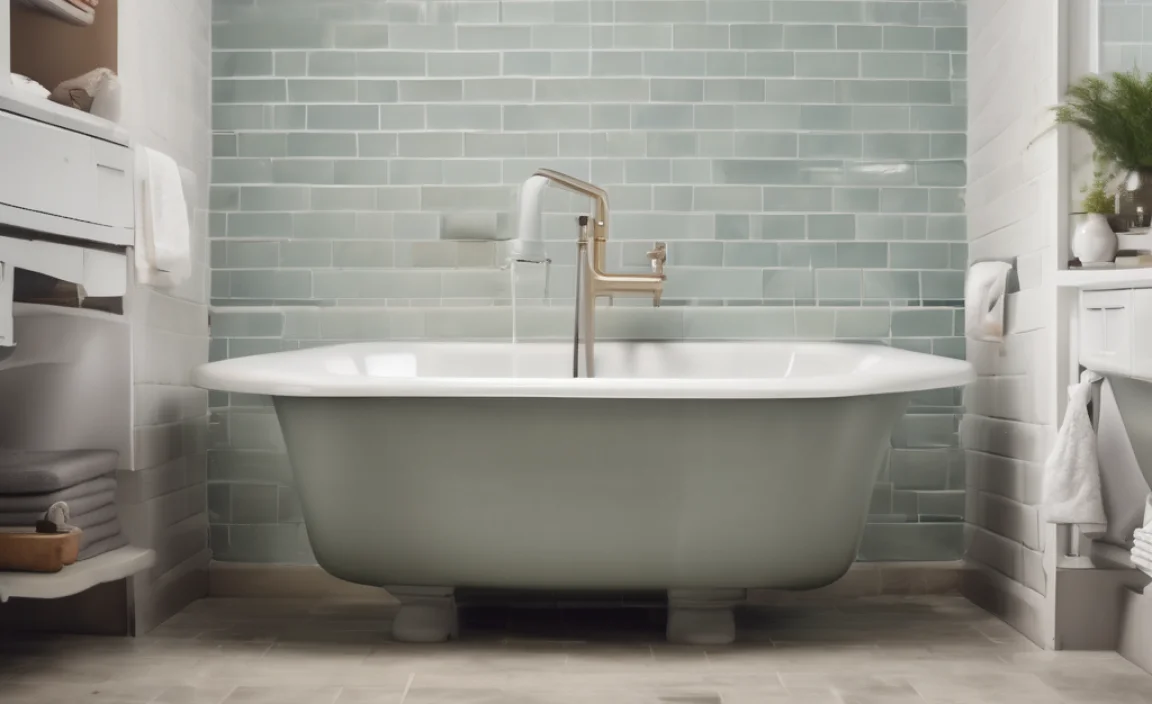Quick Summary: Sewer backup in your bathtub is gross! First, stop using water to prevent more overflow. Then, try plunging the tub and nearby drains. If that doesn’t work, check the main sewer line cleanout outside your house for clogs. For stubborn blockages, call a licensed plumber. They have the tools to fix the problem safely and effectively.
Is your bathtub filled with dirty water and debris? A sewer backup is a common and frustrating problem. It can be messy and smelly, but don’t panic! You can often tackle the issue yourself with a few simple steps. This guide will walk you through the process, step-by-step, so you can get your bathroom back to normal. We’ll cover everything from simple plunging to checking your main sewer line. Get ready to roll up your sleeves!
What Causes Sewer Backup in Your Bathtub?

Understanding the cause of a sewer backup can help you prevent it from happening again. Here are a few common reasons:
- Clogged Drainpipes: Hair, soap scum, and other debris can build up in your drainpipes, causing a blockage.
- Main Sewer Line Blockage: A clog in the main sewer line can affect all the drains in your house, including your bathtub. Tree roots are a common culprit.
- Sewer Line Damage: Cracked or collapsed sewer lines can restrict flow and cause backups.
- Heavy Rainfall: Excessive rain can overwhelm the sewer system, leading to backups in low-lying drains.
- Old or Inadequate Infrastructure: Aging or undersized sewer systems can struggle to handle the demands of a growing population.
Safety First! Important Precautions

Before you start tackling a sewer backup, keep these safety tips in mind:
- Wear Protective Gear: Always wear rubber gloves, safety glasses, and a mask to protect yourself from bacteria and contaminants in the sewer water.
- Ventilate the Area: Open windows and doors to provide ventilation and reduce the risk of inhaling harmful gases.
- Avoid Contact: Try to minimize contact with the sewer water. Wash your hands thoroughly with soap and water after any contact.
- Protect Your Belongings: Remove any valuable items from the affected area to prevent damage.
- Electrical Safety: Never use electrical appliances in standing water.
Step-by-Step Guide: Getting Rid of Sewer Backup

Here’s a step-by-step guide to help you get rid of that nasty sewer backup in your bathtub:
Step 1: Stop the Water Flow
The first thing you need to do is stop any more water from going down the drain. This includes:
- Turning off the faucet in the bathtub.
- Avoiding flushing toilets.
- Refraining from running the washing machine or dishwasher.
This will prevent the backup from getting worse.
Step 2: Plunge the Bathtub Drain
A simple plunger can often dislodge minor clogs. Here’s how to use it effectively:
- Cover the Overflow Drain: Use a wet cloth to seal the overflow drain (the small hole near the top of the tub). This will create a better seal for the plunger.
- Add Water: Make sure there’s enough water in the tub to cover the cup of the plunger.
- Plunge Vigorously: Place the plunger over the drain opening and push and pull it up and down with force. Maintain the seal.
- Repeat: Continue plunging for several minutes. You may need to repeat this process multiple times.
- Check for Drainage: After plunging, remove the plunger and see if the water drains. If it does, flush the drain with hot water for several minutes to clear any remaining debris.
Step 3: Plunge Other Nearby Drains
Sometimes, the clog might be further down the line, affecting multiple drains. Try plunging other drains in your bathroom, such as the sink and toilet. This can help to relieve pressure and dislodge the blockage.
Step 4: Check the Main Sewer Line Cleanout
The main sewer line cleanout is a capped pipe, usually located outside your house, near the foundation. It provides access to the main sewer line. Here’s how to check it:
- Locate the Cleanout: Look for a 3-4 inch capped pipe, often made of PVC, near your home’s foundation. It might be in your yard, buried slightly below ground level.
- Prepare for Potential Overflow: Place a bucket or container under the cleanout to catch any overflowing sewage.
- Carefully Remove the Cap: Use a wrench to slowly loosen and remove the cap. Be prepared for potential pressure and overflowing sewage.
- Check for Blockage: If sewage spills out, it indicates a blockage in the main sewer line. If there’s no spillage, the blockage is likely further down the line or in your house’s drainpipes.
Step 5: Use a Drain Snake
A drain snake (also called an auger) can help you reach and break up clogs deeper in the drainpipe. You can buy one at most hardware stores.
- Insert the Snake: Carefully insert the end of the drain snake into the bathtub drain opening.
- Feed the Snake: Push the snake down the drainpipe, rotating the handle as you go.
- Break Up the Clog: When you feel resistance, rotate the snake to break up or grab the clog.
- Remove the Snake: Slowly pull the snake out of the drainpipe, cleaning off any debris as you go.
- Flush with Water: After removing the snake, flush the drain with hot water to clear any remaining debris.
Step 6: Natural Drain Cleaners
If you’re looking for a natural alternative to chemical drain cleaners, try these options:
- Baking Soda and Vinegar: Pour 1 cup of baking soda down the drain, followed by 1 cup of vinegar. Let it fizz for 30 minutes, then flush with hot water.
- Boiling Water: Pour a large pot of boiling water down the drain. This can help to dissolve grease and other debris. Be careful when pouring boiling water, and avoid using it on PVC pipes, as it can damage them.
Step 7: When to Call a Plumber
If you’ve tried all the above steps and the sewer backup persists, it’s time to call a licensed plumber. Here are some situations that warrant professional help:
- Persistent Blockage: If you can’t clear the clog after repeated attempts.
- Sewage Overflow: If sewage is overflowing from the cleanout or other drains.
- Multiple Drains Affected: If multiple drains in your house are backing up.
- Suspected Sewer Line Damage: If you suspect a cracked or collapsed sewer line.
A plumber has the tools and expertise to diagnose and fix complex plumbing problems.
Tools You’ll Need

Here’s a list of the tools you might need to get rid of sewer backup:
- Rubber Gloves
- Safety Glasses
- Mask
- Plunger
- Wrench
- Bucket or Container
- Drain Snake (Auger)
- Baking Soda
- Vinegar
- Boiling Water (optional)
Preventing Future Sewer Backups

Prevention is key to avoiding future sewer backups. Here are some tips:
- Avoid Flushing Inappropriate Items: Never flush anything other than toilet paper down the toilet. This includes feminine hygiene products, diapers, wipes, and paper towels.
- Properly Dispose of Grease: Never pour grease down the drain. It can solidify and cause blockages. Instead, pour grease into a container and dispose of it in the trash.
- Install Drain Screens: Use drain screens in your bathtub and sink to catch hair and other debris.
- Regular Drain Cleaning: Flush your drains with hot water regularly to prevent buildup. You can also use natural drain cleaners like baking soda and vinegar.
- Maintain Your Sewer Line: Have your sewer line inspected periodically by a professional to check for damage or potential problems. Consider having tree roots removed if they are encroaching on your sewer line.
Understanding Sewer Line Cleanouts
Sewer line cleanouts are essential access points for maintaining your home’s plumbing system. Knowing how to locate and use them can save you time and money in the long run. Here’s a more detailed look:
Types of Cleanouts
There are several types of sewer line cleanouts, each with its own characteristics:
- Ground-Level Cleanouts: These are the most common type, typically located near the foundation of your house. They are easy to access and identify.
- Recessed Cleanouts: These are set into the ground and covered with a cap or lid. They can be harder to locate, especially if they are overgrown with grass or vegetation.
- Wall-Mounted Cleanouts: These are located on an exterior wall of your house, usually near a bathroom or kitchen.
- Indoor Cleanouts: In some older homes, cleanouts may be located inside the house, typically in a basement or crawl space.
How to Locate a Cleanout
Finding your sewer line cleanout can sometimes be challenging. Here are some tips:
- Check Your Home Inspection Report: Your home inspection report may indicate the location of the cleanout.
- Look Near the Foundation: Start by searching near the foundation of your house, especially on the side facing the street.
- Check for a Raised Pipe: Look for a short, capped pipe that sticks up slightly from the ground.
- Consult Your Local Building Department: If you can’t find the cleanout, your local building department may have records of its location.
Using a Cleanout for Maintenance
Cleanouts aren’t just for emergencies. You can also use them for routine maintenance:
- Flushing the Sewer Line: You can use a garden hose to flush out your sewer line and prevent buildup. Simply insert the hose into the cleanout and run water for several minutes.
- Inspecting the Sewer Line: A plumber can use a camera to inspect your sewer line through the cleanout, checking for damage or blockages.
Cost of Professional Plumbing Services
If you need to call a plumber, it’s helpful to have an idea of the potential costs involved. Here’s a breakdown of common plumbing services and their average prices:
| Service | Average Cost |
|---|---|
| Drain Cleaning | $100 – $300 |
| Sewer Line Cleaning | $150 – $500 |
| Sewer Line Repair | $500 – $3,000 |
| Sewer Line Replacement | $3,000 – $10,000+ |
| Emergency Plumbing Service | $150 – $500+ (plus hourly rates) |
Keep in mind that these are just averages. The actual cost may vary depending on your location, the complexity of the job, and the plumber’s rates.
DIY vs. Professional Plumber: A Comparison
Deciding whether to tackle a plumbing problem yourself or call a professional can be tricky. Here’s a comparison to help you make the right choice:
| Factor | DIY | Professional Plumber |
|---|---|---|
| Cost | Lower (cost of tools and materials) | Higher (labor and expertise) |
| Expertise | Limited to your knowledge and skills | Extensive knowledge and experience |
| Time | Can take longer, especially if you’re learning | Faster, more efficient |
| Tools | Requires you to own or rent tools | Has all necessary tools and equipment |
| Safety | Potential risk of injury or damage | Trained to handle plumbing safely |
| Warranty | No warranty on your work | Typically offers a warranty on their work |
FAQ: Sewer Backup in Bathtub
Here are some frequently asked questions about sewer backups in bathtubs:
What does sewer backup smell like?
Sewer backup smells like a combination of rotten eggs, sewage, and stagnant water. It’s a very unpleasant and distinct odor.
Is sewer backup water dangerous?
Yes, sewer backup water is dangerous. It can contain bacteria, viruses, and parasites that can cause illness. Always wear protective gear and avoid contact with the water.
Can a sewer backup cause health problems?
Yes, exposure to sewer backup can cause various health problems, including skin infections, respiratory issues, and gastrointestinal illnesses. It’s crucial to clean up the area thoroughly and disinfect any surfaces that came into contact with the water.
Will my homeowner’s insurance cover sewer backup damage?
Most homeowner’s insurance policies do not cover sewer backup damage unless you have a specific rider or endorsement for sewer backup coverage. Check your policy or contact your insurance company to find out if you’re covered.
How do I disinfect my bathtub after a sewer backup?
After removing the sewage, clean the bathtub with soap and water. Then, disinfect it with a solution of 1 part bleach to 10 parts water. Let the solution sit for 10 minutes, then rinse thoroughly.
How long does it take for a plumber to fix a sewer backup?
The time it takes for a plumber to fix a sewer backup depends on the cause and severity of the problem. A simple clog might take an hour or two, while a major sewer line repair or replacement could take several days.
Can tree roots cause sewer backups?
Yes, tree roots are a common cause of sewer backups. They can grow into sewer lines through cracks or joints, causing blockages and damage. Regular sewer line inspections and root removal can help prevent this problem.
Conclusion
Dealing with a sewer backup in your bathtub is never fun, but with a little know-how and the right tools, you can often resolve the issue yourself. Remember to prioritize safety, follow the steps outlined in this guide, and don’t hesitate to call a plumber if you’re uncomfortable or unable to fix the problem. By taking proactive measures to prevent future backups, you can keep your plumbing system running smoothly and avoid those unpleasant surprises. So, grab your gloves, get to work, and reclaim your bathroom!



